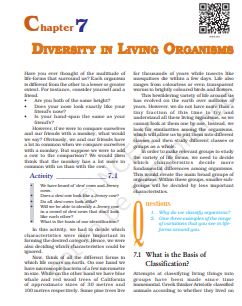‘NCERT Solutions for Class 9 Science Chapter 7‘ PDF Quick download link is given at the bottom of this article. You can see the PDF demo, size of the PDF, page numbers, and direct download Free PDF of ‘Ncert Class 9 Science Chapter 7 Exercise Solution’ using the download button.
NCERT Class 9 Science Textbook Chapter 7 With Answer PDF Free Download

Chapter 7: Diversity in Living Organisms
Have you ever thought of the multitude of life forms that surround us? Each organism is different from the other to a lesser or greater extent.
For instance, consider yourself a friend.
• Are you both of the same height?
• Does your nose look exactly like your friend’s nose?
• Is your hand span the same as your friend’s?
However, if we were to compare ourselves and our friends with a monkey, what would we say? Obviously, we and our friends have a lot in common when we compare ourselves with a monkey.
But suppose we were to add a cow to the comparison? We would then think that the monkey has a lot more in common with us than with the cow.
In this activity, we had to decide which characteristics were more important in forming the desired category. Hence, we were also deciding which characteristics could be ignored.
Now, think of all the different forms in which life occurs on earth. On one hand, we have microscopic bacteria of a few micrometers in size.
While on the other hand, we have blue whale and redwood trees in California of approximate sizes of 30 meters and 100 meters respectively.
Some pine trees live for thousands of years while insects like mosquitoes die within a few days.
Life also ranges from colorless or even transparent worms to brightly colored birds and flowers.
This bewildering variety of life around us has evolved on the earth over millions of years.
However, we do not have more than a tiny fraction of this time to try and understand all these living organisms, so we cannot look at them one by one.
Instead, we look for similarities among the organisms, which will allow us to put them into different
classes and then study different classes or groups as a whole.
In order to make relevant groups to study the variety of life forms, we need to decide which characteristics decide more fundamental differences among organisms.
This would create the main broad groups of organisms. Within these groups, smaller subgroups will be decided by less important characteristics.
7.1 What is the Basis of Classification?
Attempts at classifying living things into groups have been made since time immemorial. Greek thinker Aristotle classified animals according to whether they lived on and, in water, or in the air.
This is a very simple way of looking at life, but misleading too. For example, animals that live in the sea include corals, whales, octopuses, starfish, and sharks.
We can immediately see that these are very different from each other in numerous ways. In fact, habitat is the only point they share in common.
This is not an appropriate way of making groups of organisms to study and think about.
We, therefore, need to decide which characteristics to be used as the basis for making the broadest divisions.
Then we will have to pick the next set of characteristics for making sub-groups within these divisions. This process of classification within each group can then continue using new characteristics each time.
Before we go on, we need to think about what is meant by ‘characteristics’.
When we are trying to classify a diverse group of organisms, we need to find ways in which some of them are similar enough to be thought of together.
These ‘ways’, in fact, are details of appearance or behavior, in other words, form, and function.
| Author | NCERT |
| Language | English |
| No. of Pages | 18 |
| PDF Size | 2.5 MB |
| Category | Science |
| Source/Credits | ncert.nic.in |
NCERT Solutions Class 9 Science Chapter 7 Diversity in Living Organisms
Q1. Why do we classify organisms?
Ans:
By classifying organisms, it is easier and more convenient to study their characteristics. Similarities exhibited by various entities allow us to categorize different entities into a class and hence, study the group as a whole.
Q2. Give three examples of the range of variations that you see in life-forms around you.
Ans:
Listed below are a few ranges of variations observed in life forms:
(a) Small frog to big-whale
(b) Creeper to the eucalyptus tree
(c) Black cuckoo to colorful peacock
Q3. Which do you think is a more basic characteristic for classifying organisms?
(a) the place where they live.
(b) the kind of cells they are made of. Why?
Ans:
The most basic classification of organisms should be established on the kind of cells they are made up of. This is because the habitat can have species with different characteristics living harmoniously whereas the entities with similar cell arrangements will exhibit equivalent characteristics.
Q4. What is the primary characteristic on which the broad division of organisms is made?
Ans:
The basic characteristic on which organisms are primarily divided is the nature of cells. It is broadly classified as prokaryotic cells and eukaryotic cells, which furthermore are classified into subclasses.
Q5. On what basis are plants and animals put into different categories?
Ans:
The following is the basis for the categorization of plants and animals:
(a) The most fundamental consideration of classification is the presence and absence of a cell wall.
(b) The next important criterion is the mode of nutrition. The mechanism through which entities acquire their nutrients is used as the base for classification.
Diversity in Living Organisms NCERT Textbook With Solutions PDF Free Download
